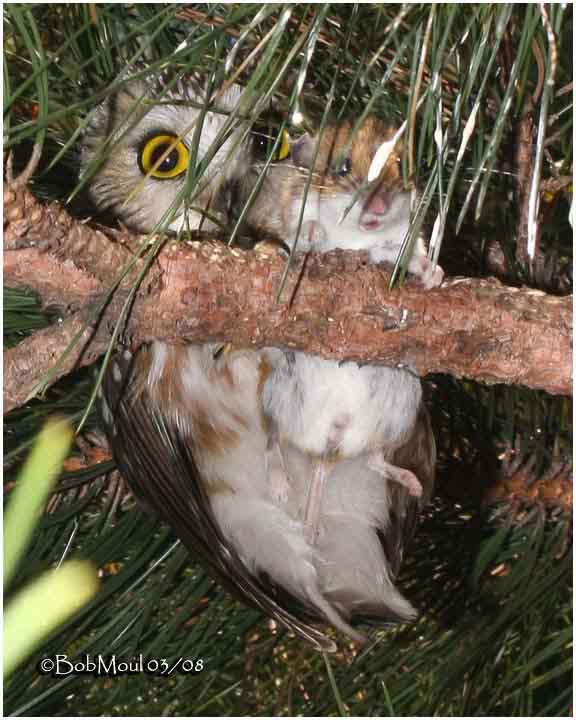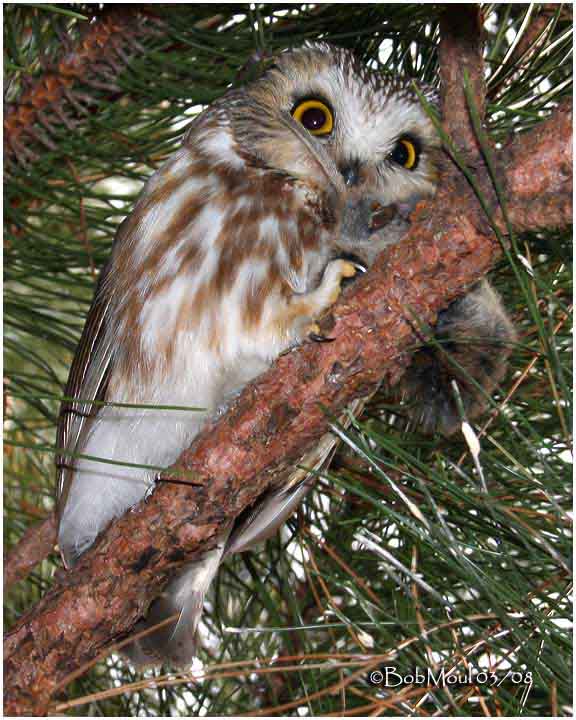
Northern Saw-whet Owl
Aegolius acadicus
Strigiforme Order – Strigidae Family
BIOMETRICS:
Length: 18-21 cm; Wingspan: 42-48 cm; Weight: M: 75g – F: 110 g
LONGEVITY: up to 16 years
DESCRIPTION:

Northern Saw-whet Owl has reddish brown upperparts.
Underparts are white, with reddish streaks. Short rounded tail shows three bars.
Head is large and rounded, reddish brown to brown. We can see a large and greyish facial disk, and white streaks on the top of head. Short neck is mottled white.
Bill is blackish and hooked. Eyes are yellow. Legs and feet are feathered.
Both sexes are similar, but female is larger than male.
Juvenile is strongly reddish above, with large white spots. Underparts are tawny-rust. White patch extends between eyes and on forehead.
VOICE: SOUNDS BY XENO-CANTO
Northern Saw-whet Owl’s call is a monotonously repeated single-note whistle, heard mainly during breeding season. Male vocalizes to attract female “toot-toot-toot-toot”. We can hear raspy call sounds like a saw being sharpened. Out of breeding season, they are silent.
When male brings food at nest, it gives some rapid “toot”, and female responds with a soft “swee”.
HABITAT:
Northern Saw-whet Owl is most common in coniferous forests. But it also inhabits mixed forests and wooded swamps.
It winters in habitat with dense vegetation. Most of populations are migratory and move southwards in autumn.
RANGE:
Northern Saw-whet Owl breeds from southern Alaska, eastwards to Nova Scotia and southwards to northern US, and southwards in mountains.
It winters within the breeding range and southwards across United States.

BEHAVIOUR:
Northern Saw-whet Owl is strictly nocturnal and solitary. It roosts during the day in dense evergreen forests, often close to the end of a branch. It hunts at night from low perch. It detects prey by sight and sound. It uses the “sit and wait” tactic, dropping down onto prey on the ground from its perch; it catches the prey with its feet. It tears it apart and eats it in small pieces. Larger prey often is partially eaten, and stored on a branch and eaten later.
It may hunt in heavy shrub cover. It may kill up to six mice rapidly, without eating any of them. These food resources are cached in safe place. In winter, this food needs to thaw, and the owl “broods” the frozen food.
These Owls eject very small pellets, with difficulties, twisting body and head.
Courtship displays begin after a female has been attracted by the male song. Male performs flight displays, circling above the female while calling. Then, it lands close to her, performing an elaborate series of bobbing and shuffling, while inching towards her. Often, male performs courtship feeding, offering a mouse to the female.
Northern Saw-whet Owls are monogamous, but if food resources are abundant, polygyny may occur. Females sometimes are polyandrous and leave the male with the nestlings while they mate with another male, raising a second brood.
FLIGHT:
Northern Saw-whet Owl has rapid flight, laboured and undulating.

REPRODUCTION:
Northern Saw-whet Owl nests in cavities, often old woodpecker holes, or natural cavities, but also in nest boxes; these cavities are often located in dead trees, at about 13 to 20 feet above the ground.
Female lays 4 to 7 eggs, laid at two days intervals. Incubation lasts about 26 to 28 days, by female. During this period, male feeds female and defends the territory.
Chicks hatch altricial, and female broods them. Male provides food at nest, and female tears it into small pieces, to feed the chicks, until they are 18 days old.
After this period, female leaves the nest and roosts elsewhere. Male, and sometimes female, continue to feed the chicks.
Chicks fledge at about 4 to 5 weeks of age, and they are able to fly. But the male feeds them for one month more.
Young become independent when they are 6 to 8 weeks old. They reach adult plumage and sexual maturity at one year.
This species may produce two broods per year, if female mates with other male after the first clutch.

DIET:
Northern Saw-whet Owl feeds mainly on small mammals such as mice, voles and lemmings. It also consumes insects, such as beetles and grasshoppers. Sometimes it may catch small birds.
PROTECTION / THREATS / STATUS:
Northern Saw-whet Owl populations are probably declining due to habitat loss. Nestling’s mortality is caused by parasites and starvation; adults are killed by collisions with vehicles.
Fr: Petite nyctale
All : Sägekauz
Esp : Mochuelo Cabezón
Ital : Civetta capogrosso des Nordamerica
Sd : Rostpärluggla
Photographs by Bob Moul
His website :
Nature Photography
Text by Nicole Bouglouan
Sources:
HANDBOOK OF THE BIRDS OF THE WORLD Vol 5 by Josep del Hoyo-Andrew Elliott-Jordi Sargatal - Lynx Edicions - ISBN: 8487334253
FIELD GUIDE TO THE BIRDS OF NORTH AMERICA - National Geographic Society - ISBN: 0792274512
All About Birds (Cornell Lab of Ornithology)
Animal Diversity Web (University of Michigan Museum of Zoology)
Bird Web (Seattle Audubon Society)
What Bird-The ultimate Bird Guide (Mitchell Waite)